Northern Lights Special
WOW! how about this picture from Alex Ganeev from near Duluth, MN!!
"On Sept. 27th, a solar wind stream hit Earth's magnetic field. Flowing from a large hole in the sun's atmosphere, the stream was fast and potent; by the early hours of Sept. 28th a strong G3-class geomagnetic storm was underway. Northern Lights spilled across the Canadian border into nearly a dozen US states."
Oberg Mountain
Thanks to @dkayserwx for the picture below who is spending some time up north this weekend to do a little fall color peeping. This is from atop Oberg Mountain near Lutsen and you can see some pretty decent color across the inland areas.
Minnesota Fall Color Update
According the MN DNR, much of the state is starting to see hints of fall color, however, there are pockets of peak color across northern Minnesota! Interestingly, some in northwestern Minnesota are already passed peak
Follow along as the fall colors change with the MN DNR map HERE:

Typical Fall Color Peak in Minnesota
Here are the typical fall color peak times across the state of Minnesota and note that areas along the northern tier of the state usually see their peak toward the 2nd half of September. However, peak color usually doesn't arrive in central Minnesota until October, but we're getting close.
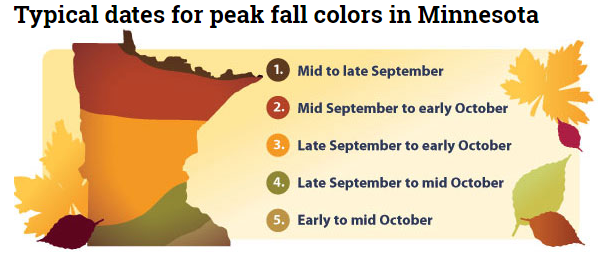
Typical Fall Color Times Across the Country
Here are the typical fall color peak times across the country, which suggests that much of the peak across the northern half of the nation usually wraps up through the month of October.
__________________________________________________________

_____________________________________________________________
More on the Record-Breaking Warmth From September 22nd-24th
"As the 2017 fall began, summer staged an impressive comeback in Minnesota. On Friday September 22nd, Minnesota found itself stuck between a strong and persistent high pressure area over the eastern United States, and a nearly stationary low pressure system and cold front to the west. In between, unseasonably warm and moist air flowed up into the state from the south and southwest, pushing temperatures into the 80s up to the Canadian border, with 90s common across the southern half of Minnesota. Dew point temperatures well into the 60s and 70s streamed into the state as well, resulting in heat index values exceeding 100 degrees in some places."
See more from MN DNR HERE:
(Image Credit: MN DNR)
 __________________________________________________________________Record Setting Accumulated Cyclone Energy
__________________________________________________________________Record Setting Accumulated Cyclone Energy
The month of September spawned several very strong hurricanes in the Atlantic basin. In fact, these storms were so strong that the amount energy that was accumulated by these storms was record setting! It narrowly beat the previous record, which was set in 2004.
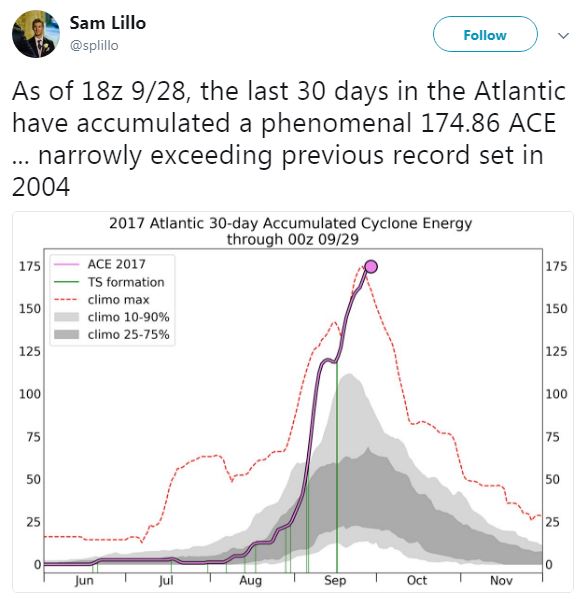 Tracking MARIA
Tracking MARIA
Follow along as the fall colors change with the MN DNR map HERE:
Typical Fall Color Peak in Minnesota
Here are the typical fall color peak times across the state of Minnesota and note that areas along the northern tier of the state usually see their peak toward the 2nd half of September. However, peak color usually doesn't arrive in central Minnesota until October, but we're getting close.
Typical Fall Color Times Across the Country
Here are the typical fall color peak times across the country, which suggests that much of the peak across the northern half of the nation usually wraps up through the month of October.
__________________________________________________________
_____________________________________________________________
"As the 2017 fall began, summer staged an impressive comeback in Minnesota. On Friday September 22nd, Minnesota found itself stuck between a strong and persistent high pressure area over the eastern United States, and a nearly stationary low pressure system and cold front to the west. In between, unseasonably warm and moist air flowed up into the state from the south and southwest, pushing temperatures into the 80s up to the Canadian border, with 90s common across the southern half of Minnesota. Dew point temperatures well into the 60s and 70s streamed into the state as well, resulting in heat index values exceeding 100 degrees in some places."
See more from MN DNR HERE:
(Image Credit: MN DNR)

The month of September spawned several very strong hurricanes in the Atlantic basin. In fact, these storms were so strong that the amount energy that was accumulated by these storms was record setting! It narrowly beat the previous record, which was set in 2004.
Here's a visible satellite image of MARIA, which as of Friday evening was still a tropical storm with sustained winds of 60mph. MARIA has had a pretty long life in the Atlantic. The National Hurricane Center starting monitoring this wave on September 13th, which became a tropical storm on the 16th and by the 18th became a category 5 hurricane with sustained winds of 160mph. The good news is that MARIA is weakening fast as is quickly lifts into the North Atlantic.
.gif)
Here's the official track from NOAA's NHC, which shows the storm quickly moving into the North Atlanctic through the weekend. The strong upper level winds are playing a big role in MARIA's quickened pace.

Tracking LEE
Here's a look at LEE, which as of Friday evening was still a tropical storm with winds of 65mph. LEE was an interesting storm because after developing into a named storm, it died out and then reformed into a hurricane, which eventually turned into a major hurricane in the central Atlantic. The good news is that LEE never came close to any major land masses.
.gif)
Tracking LEE
Just like MARIA, LEE will quickly move through the north Atlantic as strong upper level winds push it to the northeast.

Atlantic Outlook Next 5 Days
Here's the Atlantic outlook over the next few days, which shows LEE and MARIA moving quickly into the North Atlantic, but there are 2 other waves that have a LOW and MODERATE chance of tropical development over the next 5 days. Keep in mind that the Atlantic Hurricane Season doesn't officially end until November 30th, so we still have nearly 9 weeks left of potential activity.
.png)
Watching The Tropics and the Southeast
Here's the forecast from Saturday into early next week, which doesn't show anything major developing, but there certainly appears to be some activity. As we monitor this area for tropical development, we will certainly be watching this area for areas of heavy rainfall.
.gif)
Heavy Rainfall Potential
Here's the rainfall potential through Monday, which suggests areas of heavy rain across Florida and the along the coastal communities in the Gulf Coast. Some spots could see as much as 1" to 3" with localized areas of heavier rain.
__________________________________________________________
Active in the Eastern Pacific
Things have quieted down a little more in the Eastern Pacific, but according to NOAA NHC, there is a LOW probability of tropical development with a wave of energy west of Central America. Stay tuned.
.png)
___________________________________________________________
September 10th - Official Peak of the Atlantic Hurricane Season
Here's the average Atlantic hurricane season, which shows that peak activity generally occurs on September 10th and stays somewhat active through the month of October, but really diminishes through the month of November. Again, the Atlantic Hurricane Season doesn't officially end until November 30th.
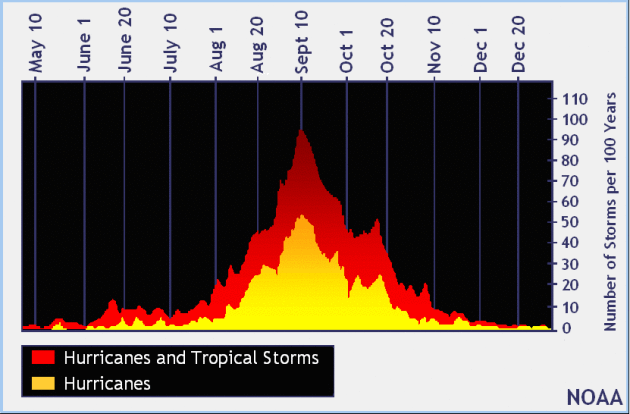
PRELIMINARY 2017 Tornado Map
It certainly has been a fairly active first half of 2017 with 1377 preliminary tornado reports through September 22nd. Note that this is the most tornadoes through September 28th since 2011, when there were 1,796 reports. The map below shows the distribution of the tornadoes so far this year.
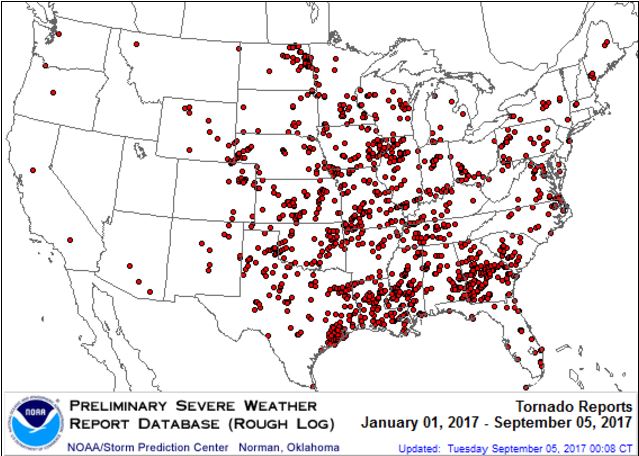 PRELIMINARY 2017 Tornado Count
PRELIMINARY 2017 Tornado Count
According to NOAA's SPC, the PRELIMINARY 2017 tornado count is 1377 (through September 28th). Note that is the most active year for tornadoes since 2011, when there were 1,796 tornadoes. Keep in mind there was a major tornado outbreak in the Gulf Coast region from April 25-28, 2011 that spawned nearly 500 tornadoes, some of which were deadly. That outbreak is known as the Super Outbreak of 2011 and has gone down in history as one of the biggest, costliest and one of the deadliest tornado outbreaks in history.
.png)
_____________________________________________________________________
According to NOAA's SPC, the PRELIMINARY 2017 tornado count is 1377 (through September 28th). Note that is the most active year for tornadoes since 2011, when there were 1,796 tornadoes. Keep in mind there was a major tornado outbreak in the Gulf Coast region from April 25-28, 2011 that spawned nearly 500 tornadoes, some of which were deadly. That outbreak is known as the Super Outbreak of 2011 and has gone down in history as one of the biggest, costliest and one of the deadliest tornado outbreaks in history.
.png)
_____________________________________________________________________
2.) Much below-normal temperatures for parts of the western U.S., Mon-Wed, Oct 2-4.
3.) Periods of heavy rain for the upper Mississippi Valley, Great Lakes, and parts of the northern and central Great Plains, Mon-Thu, Oct 2-5.
4.) Heavy rain for parts of the lower Mississippi Valley, Mon, Oct 2.
5.) Heavy rain for parts of the southern Florida peninsula and Florida Keys, Mon-Wed, Oct 2-4.
6.) Flooding occurring or imminent along the St. Johns and Withlacoochee Rivers across the Florida peninsula.
7.) Severe drought across parts of the northern Rockies, northern and central Great Plains, Midwest, and Hawaii
.png)
_________________________________________________________
"The Great Wheat Drought That Spooked Traders Seems Overblown"
"When drought spread across the Northern Plains this summer, traders feared the worst for the U.S. spring-wheat crop. Those concerns now seem overblown. The U.S. Department of Agriculture on Friday said growers harvested 416.2 million bushels of the grain this year, topping a previous outlook and the average estimate by analysts surveyed by Bloomberg. At the peak of the drought, some experts were dreading a crop as small as 300 million bushels. The agency’s report sent spring-wheat futures tumbling as much as 3.8 percent on Friday. The price is down almost 19 percent this quarter, the biggest loss in three years. Early in the summer, drought spread across much of North Dakota and Montana, the two biggest growers of the variety of grain used to make bread, bagels and pasta. Luckily for bakers, rains came later and brought some relief. At the same time, yields in Minnesota rose to the highest ever, allowing the state to become the second-largest U.S. grower, trailing North Dakota."
See more from Agweb.com HERE:
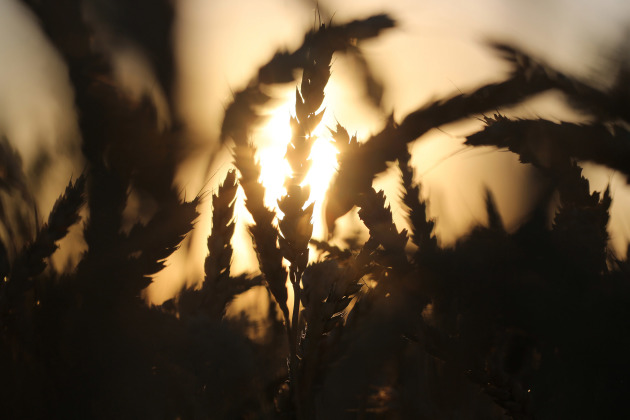
Latest Drought Monitor
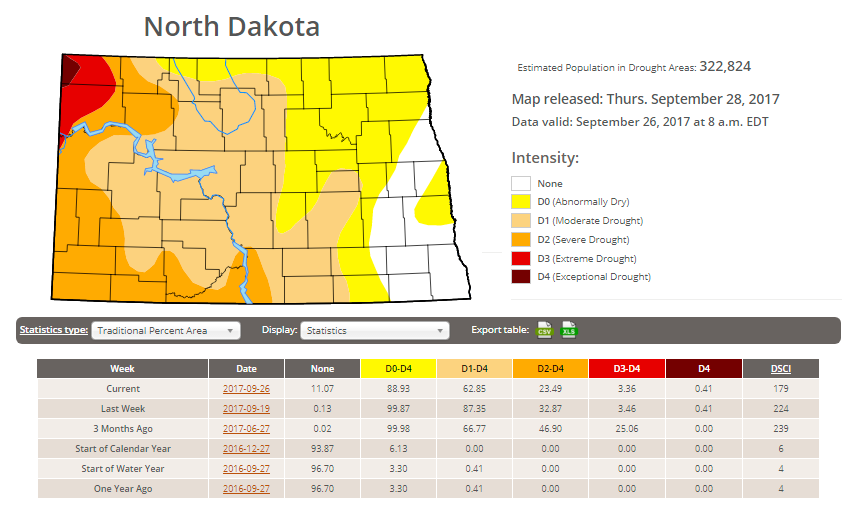
Exceptional and Extreme drought conditions are in place over parts of Montana and North and South Dakota due to several weeks/months of hot and dry weather. The image below suggests how much rain would be needed to end the drought, which suggests nearly 6" to 12"!
____________________________________________________________________
Chetco Bar Fire - 5 Miles Northeast of Brookings, OR
The Chetco Bar Fire near Brookings, Oregon is a very large wildfire in the Western US that started on Wednesday, July 12th by lightning and has grown to more than 191,000 acres! There are nearly 465 people working on this fire, which is 97% contained. The estimated containment date is set for Sunday, October 15th.
"Incident Summary: Firefighters continue to complete equipment recovery and fire suppression repair work on the Chetco Bar Fire. Over 160 miles of hose has been retrieved from the fire perimeter. Crews continue to work with chippers to dispose of brush that was cut when fire lines were constructed and to bring soil, duff and vegetation back over constructed hand lines. Excavators are working to repair dozer lines by spreading soil, duff, tree limbs and logs across the constructed lines to naturalize the area and are creating waterbars as needed to prevent soil erosion. With the return to warmer weather over the next few days, smoke may appear from very interior areas of the Chetco Bar Fire where fire could be smoldering in stump holes or large logs. Firefighters will continue to monitor and patrol the fire perimeter and respond as needed to these areas."
See more from Inciweb HERE:
(Credit: Inciweb)
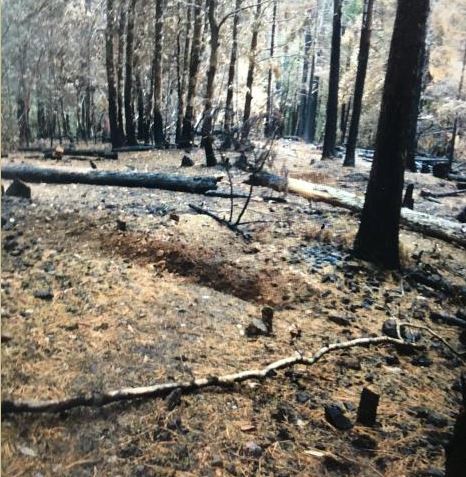
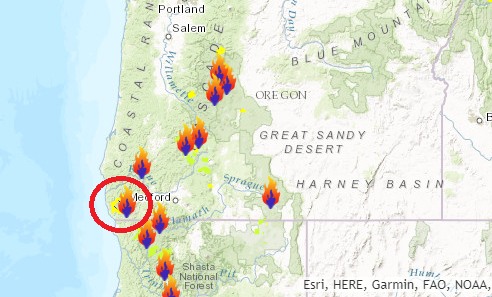 Rice Ridge Fire - 1.4 Miles NE of Seeley Lake, MT
Rice Ridge Fire - 1.4 Miles NE of Seeley Lake, MT
The Rice Ridge Fire near Sleeley Lake, MT is another very large wildfire that started on Monday, July 24th due to lightning. The fire has grown to more than 160,000 acres and is 86% contained. There are 226 people working on the fire and they hope to have it fully contained by Sunday, October 15th.
"The Rice Ridge Fire was detected on July 24, 2017. It grew to the current size of over 160,000 acres. With a change of the weather and the onset of fall, fire activity has significantly slowed although firefighters and engines continue to patrol and cool hot spots that are near the fire's edge. The perimeter in the Scapegoat and Bob Marshall Wildernesses are continually monitored for heat and fire activity.
Fire suppression repair is in full swing, with a large variety of heavy equipment and a couple hand crews working to restore road surfaces, diminish roadside slash, install erosion barriers and similar work to repair resources that were affected by fire operations. Hauling back pumps and other equipment no longer needed, removing fire protective wrap from bridges and other structures, and opening trail access is also high priority work. The Northern Rockies Wildland Fire Management Team is managing the fire, under command of Diane Hutton (IC) and Joe Sampson (IC Trainee). Refer to the daily update under the News Tab for details."
See more from inciweb HERE:
(Image Credit: Inciweb - taken on 9/14/2017)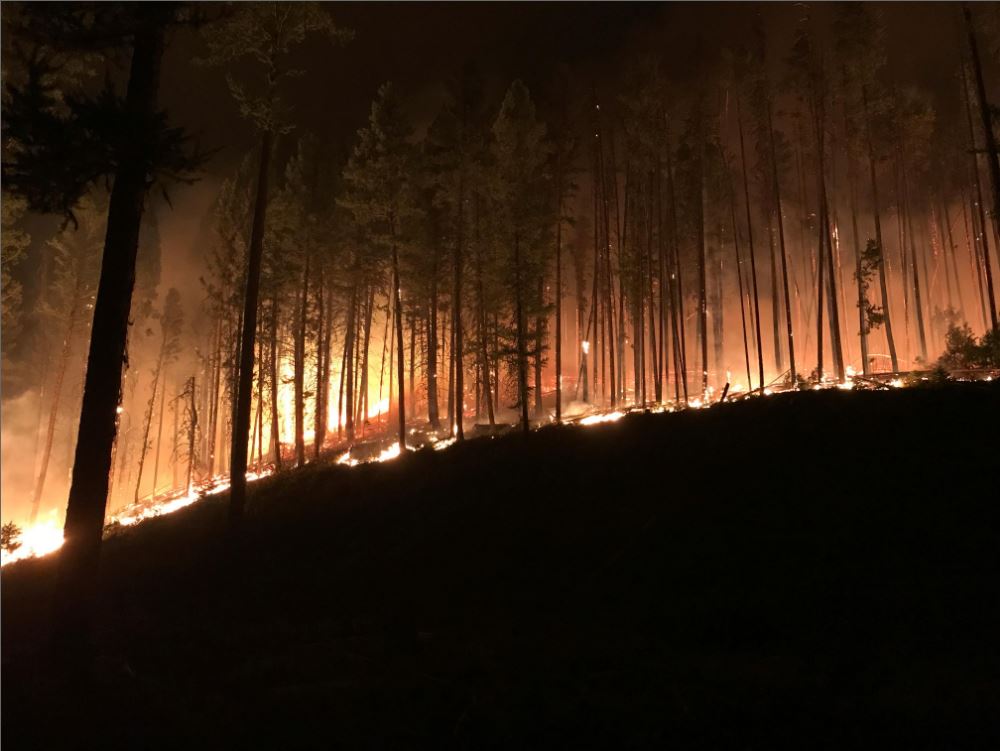

Diamond Creek Fire - Mazama, Washington
The Diamond Creek Fire near Mazama, Washington is a very large wildfire in the Western US that started on Sunday, July 23rd and has grown to more than 127,000 acres! There are nearly 202 people working on this fire, which is 77% contained. The estimated containment date is set for Sunday, October 15th.
"Incident Summary: The Diamond Creek Fire was reported on July 23, 2017 at approximately 9:45 a.m. The fire is burning in the Pasayten Wilderness and Eightmile drainage about 11 miles north of Mazama, Washington. Smokejumpers responded to the fire within two hours of it being reported. However, due to extreme terrain, heavy dead and down timber, and critical fire weather conditions, the fire was unable to be contained during initial response. The fire crossed into Canada on August 29. Fire managers recognized that the Diamond Creek Fire would likely be a long term event. Monitor, confine and point protection strategies are being used inside the Pasayten Wilderness. Outside the wilderness, the fire is being managed under a suppression strategy using a mixture of direct, indirect and point protection tactics when and where there is a high probability of success. Fire personnel will engage the fire at the appropriate time and location, while keeping public and firefighter safety as the top priority. Fire personnel are currently focused on identifying and implementing suppression repair work on the primary and contingency control lines. The suppression repair will not compromise the intended purpose of the control lines should they be needed at a later date."
See more from Inciweb HERE:
(Night time picture of a glowing yurt Credit: Brent Tannehill)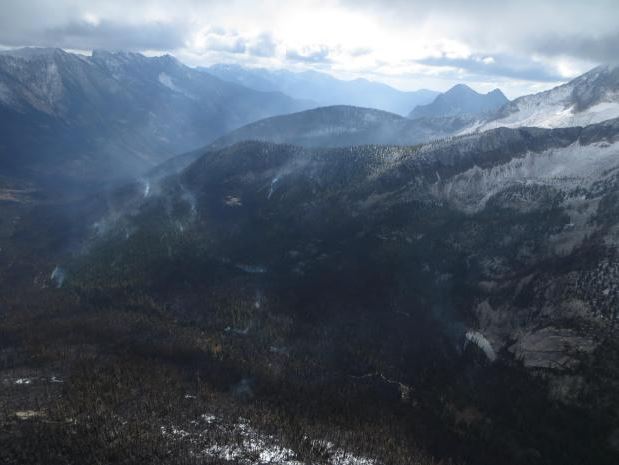
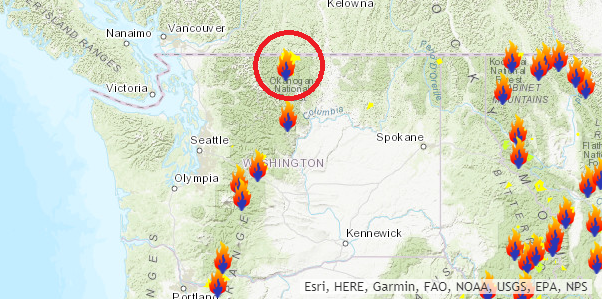 Ongoing Large Wildfires
Ongoing Large Wildfires
Here's a look at the current wildfire map across the country. While several fires are still ongoing, recent cool and somewhat wet weather has been helping curb the wildfire threat.
Here's a list of all the current large wildfires from Inciweb:

The Chetco Bar Fire near Brookings, Oregon is a very large wildfire in the Western US that started on Wednesday, July 12th by lightning and has grown to more than 191,000 acres! There are nearly 465 people working on this fire, which is 97% contained. The estimated containment date is set for Sunday, October 15th.
"Incident Summary: Firefighters continue to complete equipment recovery and fire suppression repair work on the Chetco Bar Fire. Over 160 miles of hose has been retrieved from the fire perimeter. Crews continue to work with chippers to dispose of brush that was cut when fire lines were constructed and to bring soil, duff and vegetation back over constructed hand lines. Excavators are working to repair dozer lines by spreading soil, duff, tree limbs and logs across the constructed lines to naturalize the area and are creating waterbars as needed to prevent soil erosion. With the return to warmer weather over the next few days, smoke may appear from very interior areas of the Chetco Bar Fire where fire could be smoldering in stump holes or large logs. Firefighters will continue to monitor and patrol the fire perimeter and respond as needed to these areas."
See more from Inciweb HERE:
(Credit: Inciweb)
 Rice Ridge Fire - 1.4 Miles NE of Seeley Lake, MT
Rice Ridge Fire - 1.4 Miles NE of Seeley Lake, MTThe Rice Ridge Fire near Sleeley Lake, MT is another very large wildfire that started on Monday, July 24th due to lightning. The fire has grown to more than 160,000 acres and is 86% contained. There are 226 people working on the fire and they hope to have it fully contained by Sunday, October 15th.
"The Rice Ridge Fire was detected on July 24, 2017. It grew to the current size of over 160,000 acres. With a change of the weather and the onset of fall, fire activity has significantly slowed although firefighters and engines continue to patrol and cool hot spots that are near the fire's edge. The perimeter in the Scapegoat and Bob Marshall Wildernesses are continually monitored for heat and fire activity.
Fire suppression repair is in full swing, with a large variety of heavy equipment and a couple hand crews working to restore road surfaces, diminish roadside slash, install erosion barriers and similar work to repair resources that were affected by fire operations. Hauling back pumps and other equipment no longer needed, removing fire protective wrap from bridges and other structures, and opening trail access is also high priority work. The Northern Rockies Wildland Fire Management Team is managing the fire, under command of Diane Hutton (IC) and Joe Sampson (IC Trainee). Refer to the daily update under the News Tab for details."
See more from inciweb HERE:
(Image Credit: Inciweb - taken on 9/14/2017)

Diamond Creek Fire - Mazama, Washington
The Diamond Creek Fire near Mazama, Washington is a very large wildfire in the Western US that started on Sunday, July 23rd and has grown to more than 127,000 acres! There are nearly 202 people working on this fire, which is 77% contained. The estimated containment date is set for Sunday, October 15th.
"Incident Summary: The Diamond Creek Fire was reported on July 23, 2017 at approximately 9:45 a.m. The fire is burning in the Pasayten Wilderness and Eightmile drainage about 11 miles north of Mazama, Washington. Smokejumpers responded to the fire within two hours of it being reported. However, due to extreme terrain, heavy dead and down timber, and critical fire weather conditions, the fire was unable to be contained during initial response. The fire crossed into Canada on August 29. Fire managers recognized that the Diamond Creek Fire would likely be a long term event. Monitor, confine and point protection strategies are being used inside the Pasayten Wilderness. Outside the wilderness, the fire is being managed under a suppression strategy using a mixture of direct, indirect and point protection tactics when and where there is a high probability of success. Fire personnel will engage the fire at the appropriate time and location, while keeping public and firefighter safety as the top priority. Fire personnel are currently focused on identifying and implementing suppression repair work on the primary and contingency control lines. The suppression repair will not compromise the intended purpose of the control lines should they be needed at a later date."
See more from Inciweb HERE:
(Night time picture of a glowing yurt Credit: Brent Tannehill)

Here's a look at the current wildfire map across the country. While several fires are still ongoing, recent cool and somewhat wet weather has been helping curb the wildfire threat.
Here's a list of all the current large wildfires from Inciweb:
_________________________________________________________________________
National Weather Outlook
Here's the weather outlook through the weekend, which shows a stalled front across Florida and the Gulf Coast, which will help to bring widespread T-storms to the region, some of which could produce heavy rainfall. There will also be some unsettled weather across the western half of the country, which will bring widely scattered showers to the region and snow in the mountains.
.gif)
5 Day Precipitation Outlook
According to NOAA's WPC, the next several days could produce very heavy rainfall across the Florida and the Gulf Coast with some 1" to 3"+ tallies possible. There will also be prolonged areas of rain across the Midwest and Central/High Plains. Some areas there could see 2" to 4"+ through midweek and possibly even more through the end of the week.
.gif)
.png)
.gif)
Snowfall Potential
As our next storm system moves into the Western U.S., snowfall will once again be likely across the high elevations with some 6" to 12"+ tallies possible through midweek!
.png)
________________________________________________________________________
Sunny Saturday. Wet Sunday & First Week of October
By Todd Nelson, filling in for DouglasSeptember 2017 comes to an end today and thankfully so as we wrap up what has been an incredibly active month in the tropics.
Many living in Hurricane Alley endured significant damage from Hurricanes Harvey, Irma and Maria. From historic flooding in Houston to devastation from two separate major hurricanes in the Caribbean and Florida, it will likely take months and years to rebuild. For some, life may never be the same.
Thanks to a fairly stagnant weather patter this month, the Twin Cities will end nearly 2 inches below average and 5.5 degrees above average. That trend is our friend today as mostly sunny and mild temps linger.
Our next chance of rain moves in Sunday and could be very puddley through Thursday. Those running the Twin Cities Marathon Sunday should plan on soggy course conditions.
The front stalls across the state through much of the first full week of October, which could result in widespread 2 to 4 inch rainfall tallies across the southern half of the state.
Enjoy the sun today. Umbrellas come next.
________________________________________________________________________
By Todd Nelson, filling in for DouglasSeptember 2017 comes to an end today and thankfully so as we wrap up what has been an incredibly active month in the tropics.
Many living in Hurricane Alley endured significant damage from Hurricanes Harvey, Irma and Maria. From historic flooding in Houston to devastation from two separate major hurricanes in the Caribbean and Florida, it will likely take months and years to rebuild. For some, life may never be the same.
Thanks to a fairly stagnant weather patter this month, the Twin Cities will end nearly 2 inches below average and 5.5 degrees above average. That trend is our friend today as mostly sunny and mild temps linger.
Our next chance of rain moves in Sunday and could be very puddley through Thursday. Those running the Twin Cities Marathon Sunday should plan on soggy course conditions.
The front stalls across the state through much of the first full week of October, which could result in widespread 2 to 4 inch rainfall tallies across the southern half of the state.
Enjoy the sun today. Umbrellas come next.
________________________________________________________________________
Extended Forecast
SATURDAY: Dry day. Clouds thicken with showers overnight. Winds: SE 10-15. High: 65.
SATURDAY NIGHT: Mostly cloudy with scattered showers developing late. Winds: SSE 10-15. Low: 54.
SUNDAY: Cloudy and breezy with scattered showers. Winds: SSE 10-20. High: 66.
MONDAY: Numerous puddles. A few rumbles. Winds: SSE 10-15. Wake-up: 55. High: 68.
TUESDAY: Mostly cloudy with more T-storms. Winds: S 5-10. High: 70.
WEDNESDAY: Another soggy day. Lingering storms. Winds: WSW 5-10. Wake-up: 55. High: 71.
THURSDAY: Few AM showers. Slow PM clearing. Winds: WNW 5-10. Wake-up: 53. High: 67.
FRIDAY: Sun returns. FINALLY! Winds: WSW 5-10. Wake-up: 50. High: 68.
_______________________________________________________
_______________________________________________________
This Day in Weather History
September 30th
September 30th
1995: Lightning starts a house on fire in Washington County.
1985: 4 inches of snow falls in Ely, with just a trace in the Twin Cities.
________________________________________________________
________________________________________________________
Average High/Low for Minneapolis
September 30th
September 30th
Average High: 65F (Record: 87F set in 1897)
Average Low: 46F (Record: 26F set in 1939)
Average Low: 46F (Record: 26F set in 1939)
Record Rainfall: 1.06" set in 2007
Record Snowfall: 0.1" set in 1961
_________________________________________________________
Record Snowfall: 0.1" set in 1961
_________________________________________________________
Sunrise/Sunset Times for Minneapolis
September 30th
September 30th
Sunrise: 7:10am
Sunset: 6:55pm
Sunset: 6:55pm
Hours of Daylight: ~11 hours 45 mins
Daylight LOST since yesterday: ~3 minutes and 6 seconds
Daylight LOST since summer solstice (June 20th): 3 hours & 52 minutes
__________________________________________________________
Daylight LOST since summer solstice (June 20th): 3 hours & 52 minutes
__________________________________________________________
Moon Phase for September 30th at Midnight
3.2 Days Since First Quarter
3.2 Days Since First Quarter
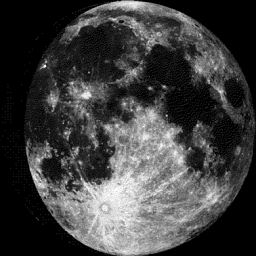
_________________________
Weather Outlook For Saturday
Saturday will be a fairly cool day, but it'll be pretty seasonal for the last day of September. Many locations across western and southern Minnesota will warm into the 60s, while those in the northeastern part of the state will only warm into the 50s. The air will also be crisp as dewpoints hover around 50F.
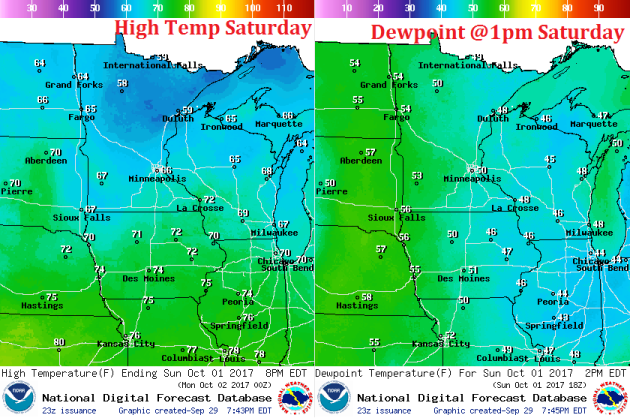
Weather Outlook For Saturday
Winds will pick up a bit out of the southeast on Saturday afternoon and be sustained around 10-20mph. There could even be gusts up to 25mph+ across the western part of the state.
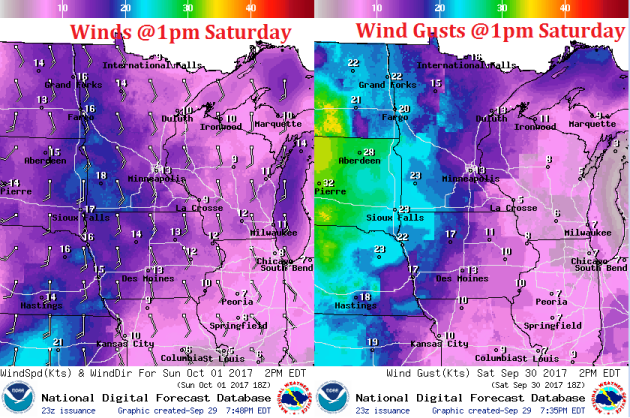
Saturday will be another mostly sunny day across much of the state. Clouds will be on the increase during the second half of the day, especially in the western part of the state as a few showers begin to move into the region.